Advanced Peak Processing to Reduce Efforts in Method Optimization
Partial coelution of chromatographic peaks is an often-encountered issue in high performance liquid chromatography (HPLC) analysis, despite best efforts in method development and optimization. Even though there are several ways of integration of overlapping signals, accurate quantification of single compounds using conventional photodiode array (PDA) detection is almost impossible without baseline separation. While extensive signal processing is well established in spectroscopic analyses such as infrared (IR) or nuclear magnetic resonance (NMR), it has not yet been commonly adapted to improve chromatographic data evaluation. This article introduces the theory and application of a novel data analysis technique for PDA detection to accurately determine and quantify single compounds, even from overlapping peaks, without the need for mass spectrometry (MS) detection.
Sergii/stock.adobe.com

Partial coelution of chromatographic peaks is an often-encountered issue in high performance liquid chromatography (HPLC) analysis, despite best efforts in method development and optimization. Even though there are several ways of integration of overlapping signals, accurate quantification of single compounds using conventional photodiode array (PDA) detection is almost impossible without baseline separation. While extensive signal processing is well established in spectroscopic analyses such as infrared (IR) or nuclear magnetic resonance (NMR), it has not yet been commonly adapted to improve chromatographic data evaluation. This article introduces the theory and application of a novel data analysis technique for PDA detection to accurately determine and quantify single compounds, even from overlapping peaks, without the need for mass spectrometry (MS) detection.
Despite advances in separation technologies, chromatographic method development, and optimization tools, coelution of compound peaks is still a common issue. Achieving baseline separation can be a challenge, particularly in complex samples with a large number of analytes or with isomers that can’t be distinguished by different mass and exhibit similar elution behaviour. There are a number of integration options for overlapping peaks, such as valleyâtoâvalley integration, perpendicular drop, or peak skim method as visualized in Figure 1, but none of them offer truly accurate quantification of the single compounds. To quote John Dolan’s “LC Troubleshooting” advice: “Integration of poorly resolved peaks is only an estimate of the more accurate results you would get when the peaks are baseline resolved” (1).
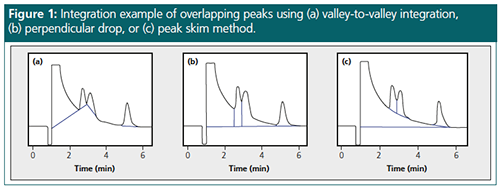
However, despite best efforts, baseline separation is sometimes more easily said than done, and achieving that last extra bit of resolution considerably increases the time and effort, and hence cost, of method development.
An alternative is the use of intelligent peak deconvolution analysis (i-PDeA), where multivariate curve resolution-alternating least squares (MCR-ALS) is applied to photodiode array (PDA) detector data, so that single analytes can be extracted from coeluting peaks (2). This novel approach enables visualization and detection of a minor single impurity even when it is coeluting with a main component. It therefore facilitates the individual, accurate quantification of hard-to-separate peaks through computer processing and deconvolution of spectral information, thereby reducing the effort required to further optimize separation parameters.
Multivariate Curve ResolutionâAlternating Least Squares (MCR-ALS)
MCR-ALS is a powerful tool that allows underlying elution and spectral profiles for a chromatogram to be estimated, even in the case of complete overlap of peaks. As the PDA detector collects full spectral data, it allows the construction of a multidimensional data matrix. MCRâALS is used to decompose the observed data matrix (D) of a chromatogram into elution (C) and pure spectral profiles (ST) that optimally fit the data matrix. Considering measurement error, noise, and unpredictable factors, and given a remainder, R, the measurement data can be modelled as D = CST + R (2,3). This relational expression is valid for any number of components (Figure 2).
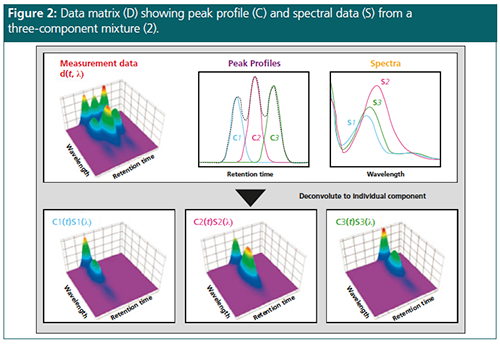
Peak Deconvolution for Incomplete Separation of Polymer Additives
The merit of individual, accurate quantification of the three antioxidants in a gel permeation chromatography (GPC) run that doesn’t offer baseline separation is described in the following paragraph. It saves the time and effort associated with setting up a second, separate method for analysis and quantification of the additives.
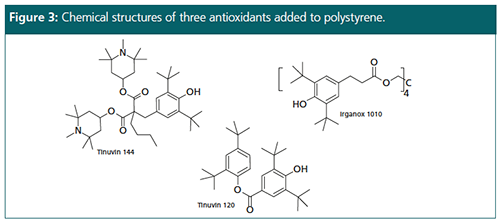
Method: column: 300 × 8 mm shimâpack GPC 805 + 801 (Shimadzu); mobile phase: THF; flow rate: 0.8 mL/min; oven temperature: 40 °C; injection volume 10 µL; sample 0.5% polystyrene containing three additives.
In the simultaneous determination of molecular weight distribution of polymer compounds by GPC using a refractive index detector and polymer additives in
an additional PDA detector, separation of these additives is almost impossible on any GPC column, due to very small differences in molecular weight of these antioxidants.
Figure 4(a) shows the PDA chromatogram of the analysis of polystyrene in the presence of three antioxidants at 240 nm, with only two peaks in addition to the polystyrene signal. In Figure 4(b) the extracted traces of each single compound after peak deconvolution using i-PDeA can be seen. The obtained peak areas were used for accurate quantification of the amount of each additive in the polystyrene sample.
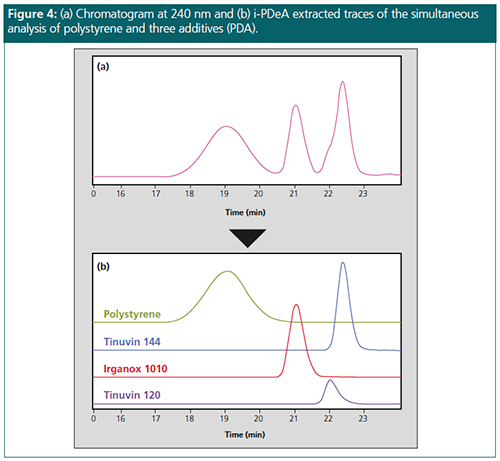
Calibration curves for the three compounds were created in the range 0.01 to 0.1% (w/v). Linearity of this calibration curve and quantitative results of each antioxidant from six consecutive injections are summarized in Table 1.

Conclusion
While digital peak processing to improve data quality is widely accepted in the field of spectroscopy, separation scientists have so far been hesitant to adapt mathematical manipulations to enhance peak resolution and evaluation. A peak deconvolution algorithm, embedded in the chromatographic data system, has been shown to aid in the interpretation of data from overlapping peaks and to enable accurate quantification of single components without the need for time-consuming method optimization to achieve baseline resolution. In an application example, this technology was used for simultaneous determination of polystyrene and antioxidant additives in a single GPC run.
This approach can also be applied as a cost-effective alternative to mass spectrometry (MS), especially for analysis of isomers with similar retention behaviour and identical mass-to-charge ratio (m/z) values.
References
- J. Dolan, LCGC North America27(10), 892–899 (2009).
- T. Yanagisawa, Technical Report C191-E042: New Data Processing Method for Photodiode Array Detectors (Shimadzu Corporation, Japan): https://www.shimadzu.com/an/literature/hplc/jpl217011.html
- M.F. Wahab G. Hellinghausen, and D.W. Armstrong, Recent Developments in HPLC, Supplement to LCGC Europe32(s5), 22–28 (2019).
Gesa Johanna Schad graduated with a Diploma in chemical engineering from the Technical University NTA in Isny, Germany, in 2004 and as a Master of Science in pharmaceutical analysis from the University of Strathclyde in Glasgow, UK, in 2005. She worked until 2006 as a consultant in HPLC method development and validation in an analytical laboratory of the FAO/IAEA in Vienna, Austria. She gained her doctorate for research in pharmaceutical sciences at the University of Strathclyde in 2010 and was employed as HPLC specialist in the R&D department at Hichrom Ltd in Reading, UK, from 2009. Since 2013, she has worked as a HPLC product specialist and since 2015 as HPLC Product Manager in the analytical business unit of Shimadzu Europa in Duisburg, Germany.
E-mail: shimadzu@shimadzu.euWebsite: www.shimadzu.eu
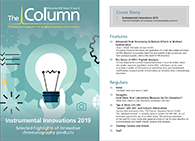
New Study Reviews Chromatography Methods for Flavonoid Analysis
April 21st 2025Flavonoids are widely used metabolites that carry out various functions in different industries, such as food and cosmetics. Detecting, separating, and quantifying them in fruit species can be a complicated process.
Extracting Estrogenic Hormones Using Rotating Disk and Modified Clays
April 14th 2025University of Caldas and University of Chile researchers extracted estrogenic hormones from wastewater samples using rotating disk sorption extraction. After extraction, the concentrated analytes were measured using liquid chromatography coupled with photodiode array detection (HPLC-PDA).

.png&w=3840&q=75)

.png&w=3840&q=75)



.png&w=3840&q=75)



.png&w=3840&q=75)









